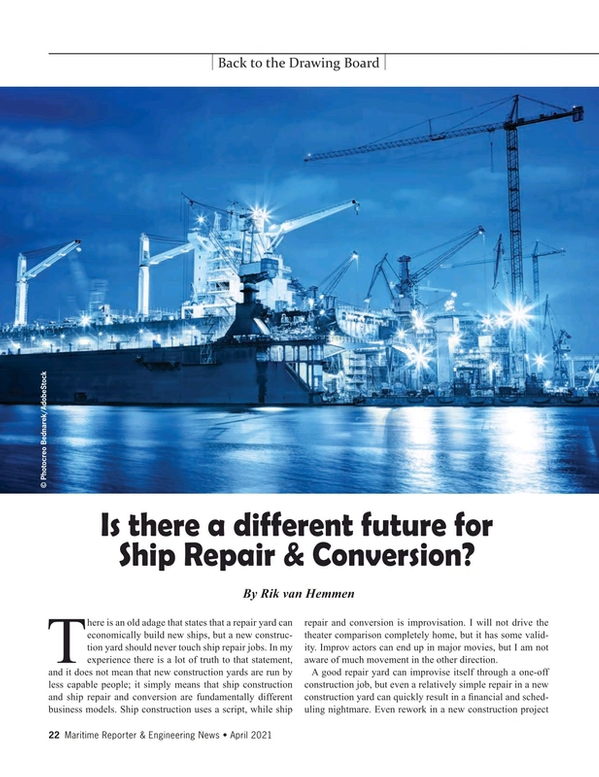
Shipbuilding: Is there a different future for ship repair and conversion?
There is an old adage that states that a repair yard can economically build new ships, but a new construction yard should never touch ship repair jobs. In my experience there is a lot of truth to that statement, and it does not mean that new construction yards are run by less capable people; it simply means that ship construction and ship repair and conversion are fundamentally different business models. Ship construction uses a script, while ship repair and conversion is improvisation. I will not drive the theater comparison completely home, but it has some validity. Improv actors can end up in major movies, but I am not aware of much movement in the other direction.
A good repair yard can improvise itself through a one-off construction job, but even a relatively simple repair in a new construction yard can quickly result in a financial and scheduling nightmare. Even rework in a new construction project can result in a financial disaster and we often advise against a new construction yard engaging in repairs even if the damage occurred in their own yard.
On the other hand, we also often encounter too much improvisation in repair yards. Good planning, tight process control and use of the most mature new construction approaches can provide interesting opportunities for the maritime community in ship repair and conversion.
There has been a revolution in ship construction and only a small portion of that revolution has been adopted in the ship repair and conversion community. The adoption of those technologies, approaches, and systems into ship repair could very well change the way ship owners and operators regard repair and conversion and that would result in new repair and conversion approaches.
Major steel repair projects traditionally required the vessel to enter the repair yard and involved detailed surveys assisted with ship’s drawings which then resulted in a repair plan. There may be CAD drawings and even a rudimentary 3D model, but only the newest ships would be fully built, configured and assembled with a full CAD model. A full CAD model with all material properties, suppliers, part numbers and models would make a major steel repair planning a hands off routines as long as the damage extent is known. Once the damage extent is known the full design model can be used to design the most efficient repair.
I am not stating anything new here, but today this approach is rarely applied. I have yet to attend a major steel repair project where this level of information transfer actually occurred. I can see there are various hurdles, and, almost ironically, the vessel’s builder may actually muscle in on the repair project because they hold the keys to the deeper data and can therefore reduce the repair cost. I am not saying the builder will be successful in getting the project, because ships have a nasty habit of getting damaged in locations that are some distance away from her place of birth, and often the vessel is incapable of being economically moved. Regardless, this shows that technology adoptions result in business model shifts.
While I have not seen the use of full digital models in a large steel repair job, the recent installation of Ballast Water Treatment systems and scrubbers has made much more use of digital construction details especially in the planning phase, and these modifications were much more cost effective when a full E/R 3D model was available.
So let’s dig a little deeper, because there are number of technologies that are pretty well established in ship construction that could come into play in ship repair and conversion and may dramatically change the game.
Table 1 shows a list of technologies and my take on their present adoptions.
Table 1: The ‘Cutting Edge’ in Ship Repair
• Full digital construction model
3D CAD is nice, but where digital modeling becomes really valuable is the inclusion of detailed parts information. Shipbuilders are operating at this level, but repair yards rarely are provided with these details.
• Laser scanning
Laser scanning is already being used for dimensional determination and verification by ship repairers, but where laser scanning becomes even more valuable is for confimation between as designed and as built dimensions. If the model and the as built dimensioning can be tightly integrated the construction as repair or conversion modules can be performed neat.
• Drones
Drone inspection are still in their infancy and inspections is only the tip of the drone iceberg. Ships are big and staging is expensive. Anything that replaces staging or human climbing saves money in ship repair and concersion
• 3D plastic printing
3D plastic printing has limited use in commerical ship contruction, but should also not be underestimated. Some parts may be reproducable with 3D printing and if new ship parts are 3D printed the repair part can also be 3D printed. Meanwhile 3D printed parts can be invaluable in jigging, patterns or spacers.
• 3D metal printing
3D metal printing is still in its infancy as far as direct application in ship building and repair is concerned, but the promise is spectacular and may be even higher in repair and conversion than new construction. NC cutting and machiningNC cutting is already quite common in ship repair facilities, since even rough and simple NC part cutting saves money, but to cut exact parts from an exact model will introduce an additional huge repair cost saving. (Click here to see related story on 3D printing)
• Automated welding
Various automated welding approaches are already being used by repairers, but closer tolerances in modeling will increase the use of automated welding approaches.
So how would ship repair and construction industry change with the adoption of these technologies?
It becomes economic math. If it is cheaper to build new than convert; shipowners will build new. But if it is cheaper to repair or convert; shipowners will repair and convert.
Especially with regard to conversion, the availability of a full digital model of the ship is an astonishing cost saving. I am presently involved in a complex conversion project where there is no original digital model. The conversion yard knows how to use many of the tools I mention (especially NC cutting and machining) and will take full advantage of them, but the creation of the model and then the conversion design is a very significant percentage of the overall project cost (and timeline). If the original digital design were available, I estimate the conversion cost would be reduced by 10% or more.
Today shipbuilders hold the technology edge, but once these technologies become firmly imbedded in the repair and conversion industry, the cutting edge will shift. This is nothing new. Change is constant and these shifts have occurred in maritime and ashore. The US maritime industry was heavily skewed to repair due to high ship construction costs (and still is in the Great Lakes) and car repairs will be much reduced in the coming years if EVs become dominant.
Interestingly, as far as ship repair and conversion is concerned, central to all of this is access to the full digital ship construction model. As near as I am aware, shipbuilders are far from eager to provide it to the vessel purchaser, since it is a serious bit of intellectual property. But in a weak building market everything is negotiable, and to have the model leave the shipyard with the ship or to ensure full access to the model in the ship construction contract may very well be the bell weather in a shift in ship repair and conversion. As a general benefit it may increase ship useful lives and reduce waste and scrapping problems. Now if we can make ships from less corrosive materials (see https://www.marinelink.com/news/eye-design-a-titanium-uss-enterprise-ncc-478807), who knows how fast things will change.
For each column I write, MREN has agreed to make a small donation to an organization of my choice. For this column I nominate Mystic Seaport, an organization with one of the country’s most important repair shops.
- Click here to see related story "Ship Repair Goes Digitial"
Read Shipbuilding: Is there a different future for ship repair and conversion? in Pdf, Flash or Html5 edition of April 2021 Maritime Reporter
Other stories from April 2021 issue
Content
- Training Tips For Ships - Tip #23: Is Your Training Technology Disaster-Ready? page: 12
- Favorable Offshore Winds Blowing from the Biden Administration page: 14
- Shipbuilding: Is there a different future for ship repair and conversion? page: 22
- Tech File: Naval Postgraduate School Adds Xerox ElemX 3D Printer page: 24
- Facing Maritime’s Challenges, S.M.C.'s Kozdron reasons “That's why we are here: Engineers.” page: 26
- Inside the Red-Hot Offshore Wind Energy Market page: 34
- Maritime Digitalizaton: The Electronic Lookout page: 50
- Ship Repair Tech: Ship Repair Goes Digital page: 53


